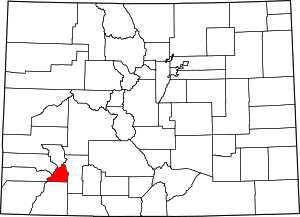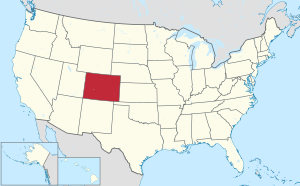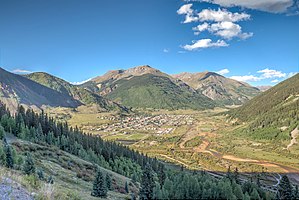San Juan County | |
|---|---|
 The San Juan County Courthouse in Silverton | |
 Location within the U.S. state of Colorado | |
 Colorado's location within the U.S. | |
| Coordinates: 37°46′N 107°40′W / 37.77°N 107.67°W | |
| Country | |
| State | |
| Founded | January 31, 1876 |
| Named for | San Juan River |
| Seat | Silverton |
| Largest town | Silverton |
| Area | |
| • Total | 388 sq mi (1,000 km2) |
| • Land | 387 sq mi (1,000 km2) |
| • Water | 0.8 sq mi (2 km2) 0.2% |
| Population (2020) | |
| • Total | 705 |
| • Density | 1.8/sq mi (0.7/km2) |
| Time zone | UTC−7 (Mountain) |
| • Summer (DST) | UTC−6 (MDT) |
| Congressional district | 3rd |
| Website | sanjuancounty |
San Juan County is a county located in the U.S. state of Colorado. As of the 2020 census, the population was 705,[1] making it the least populous county in Colorado. The county seat and the only incorporated municipality in the county is Silverton.[2] The county name is the Spanish language name for "Saint John", the name Spanish explorers gave to a river and the mountain range in the area. With a mean elevation of 11,240 feet (3,430 meters), San Juan County is the highest county in the United States and also has the two highest elevation houses in the United States; the ‘Bonnie Belle’ above Animas Forks at 11,900’ – 11,950’ elevation and an unnamed house above Picayune Gulch at 12,000’ elevation.
History
[edit]Long before European settlement, the area was regularly explored by the Anasazi, and later the Utes, who hunted and lived in the San Juans during the summer.[3] There is also speculation that Spanish explorers and fur traders ventured into the area in the 1600s and 1700s.[3]
Permanent settlement in the area surrounding present-day San Juan County began in 1860, near the end of the Colorado Gold Rush. These first settlers were a group of prospectors led by Charles Baker, who made their way into the San Juan Mountains searching for gold.[4]
After the Brunot Agreement with the Utes in 1873, which exchanged four million acres (6,200 sq mi; 16,000 km2) for the Southern Ute Indian Reservation and $25,000 per year, several mining camps were constructed.[5] These would later become the communities of Howardsville, Eureka, and Silverton. San Juan County was formed on January 31, 1876, from part of La Plata County.
The region boomed after George Howard and R. J. McNutt discovered the Sunnyside silver vein along Hurricane Peak, outside the mining camp of Eureka. Gold was then discovered in 1882, which helped the county weather the Panic of 1893 far better than other mining communities, such as Aspen or Creede.[4] The Sunnyside Mine would become one of Colorado's longest running and most productive mines.[6]
Mining operators in the San Juan mountain area of Colorado formed the San Juan District Mining Association (SJDMA) in 1903, as a direct result of a Western Federation of Miners proposal to the Telluride Mining Association for the eight-hour day, which had been approved in a referendum by 72 percent of Colorado voters.[7] The new association consolidated the power of thirty-six mining properties in San Miguel, Ouray, and San Juan Counties.[8] The SJDMA refused to consider any reduction in hours or increase in wages, helping to provoke a bitter strike.
The Sunnyside mine was shut down after the 1929 stock market crash, but was acquired by Standard Metals Corp. in 1959, and reopened, finding gold in 1973 with the Little Mary vein. The county's economy was dealt a devastating blow in 1992 when the mine and the corresponding Shenandoah-Dives mill, the last operating in the region, permanently closed.[9][6] The closure meant the end of jobs for over one third of the county's workforce.[9]
Geography
[edit]According to the U.S. Census Bureau, the county has a total area of 388 square miles (1,000 km2), of which 387 square miles (1,000 km2) is land and 0.8 square miles (2.1 km2) (0.2%) is water.[10] It is the fifth-smallest county in Colorado by area. The county is located in the heart of the San Juan Mountains of Colorado. Though it has the highest mean elevation of any county in the United States, at 11,240 feet (3,430 m), none of Colorado's 53 fourteeners (mountains at least 14,000 feet in elevation) are in San Juan County.[11]
Adjacent counties
[edit]- Ouray County – north
- Hinsdale County – east
- La Plata County – south
- Montezuma County – southwest
- Dolores County – west
- San Miguel County – northwest
Major highways
[edit]
National protected areas
[edit]- Durango-Silverton Narrow-Gauge Railroad National Historic District
- Rio Grande National Forest
- San Juan National Forest
- Shenandoah-Dives (Mayflower) Mill
- Silverton National Historic District
- Uncompahgre National Forest
- Weminuche Wilderness
Trails and byways
[edit]- Alpine Loop National Back Country Byway
- Colorado Trail
- Continental Divide National Scenic Trail
- San Juan Skyway National Scenic Byway
Demographics
[edit]| Census | Pop. | Note | %± |
|---|---|---|---|
| 1880 | 1,087 | — | |
| 1890 | 1,572 | 44.6% | |
| 1900 | 2,342 | 49.0% | |
| 1910 | 3,063 | 30.8% | |
| 1920 | 1,700 | −44.5% | |
| 1930 | 1,935 | 13.8% | |
| 1940 | 1,439 | −25.6% | |
| 1950 | 1,471 | 2.2% | |
| 1960 | 849 | −42.3% | |
| 1970 | 831 | −2.1% | |
| 1980 | 833 | 0.2% | |
| 1990 | 745 | −10.6% | |
| 2000 | 558 | −25.1% | |
| 2010 | 699 | 25.3% | |
| 2020 | 705 | 0.9% | |
| 2023 (est.) | 802 | [12] | 13.8% |
| U.S. Decennial Census[13] 1790–1960[14] 1900–1990[15] 1990–2000[16] 2010–2020[1] | |||
As of the census of 2000, there were 558 people, 269 households, and 157 families residing in the county. The population density was one person per square mile (0.39 person/km2). There were 632 housing units at an average density of 2 per square mile (0.77/km2). The racial makeup of the county was 97.13% White, 0.72% Native American, 0.18% Asian, 0.36% Pacific Islander, 0.72% from other races, and 0.90% from two or more races. 7.35% of the population were Hispanic or Latino of any race.
There were 269 households, out of which 23.80% had children under the age of 18 living with them, 43.90% were married couples living together, 8.90% had a female householder with no husband present, and 41.30% were non-families. 36.80% of all households were made up of individuals, and 4.80% had someone living alone who was 65 years of age or older. The average household size was 2.06 and the average family size was 2.63.
In the county, the population was spread out, with 20.10% under the age of 18, 4.30% from 18 to 24, 28.10% from 25 to 44, 40.50% from 45 to 64, and 7.00% who were 65 years of age or older. The median age was 44 years. For every 100 females, there were 110.60 males. For every 100 females age 18 and over, there were 112.40 males.
The median income for a household in the county was $30,764, and the median income for a family was $40,000. Males had a median income of $30,588 versus $19,545 for females. The per capita income for the county was $17,584. About 13.50% of families and 20.90% of the population were below the poverty line, including 29.40% of those under age 18 and 7.10% of those age 65 or over.
San Juan county is the only county outside Alaska where walking is the most common form of commute to work. As of 2013, 33% of residents walked to work, 18% drove alone, 19% carpooled, and 18% bicycled, though the small population size introduces considerable margins of error to these statistics.[17]
As of November 2006, the one and only local school had 53 students in grades K–12.
Communities
[edit]Town
[edit]Unincorporated communities
[edit]Former communities
[edit]- Animas Forks (restored ghost town)
- Eureka (ghost town)
Politics
[edit]In the era of William Jennings Bryan, San Juan County strongly favored the Democratic Party: no Republican managed to carry the county between 1892 and 1916, and it was even one of the few northern or western counties to vote for Alton B. Parker in 1904. It remained a Democratic-leaning county until the 1960s but then turned towards the Republican Party in subsequent decades. No Democratic presidential nominee won San Juan County between 1968 and 2000, although it was one of fifteen rural or remote counties to give a plurality to Ross Perot in 1992. Since John Kerry carried the county for his party for the first time in four decades at the 2004 election, San Juan County has voted Democratic at the last five Presidential elections.
| Year | Republican | Democratic | Third party | |||
|---|---|---|---|---|---|---|
| No. | % | No. | % | No. | % | |
| 2020 | 202 | 35.94% | 342 | 60.85% | 18 | 3.20% |
| 2016 | 215 | 42.49% | 265 | 52.37% | 26 | 5.14% |
| 2012 | 212 | 41.90% | 266 | 52.57% | 28 | 5.53% |
| 2008 | 218 | 43.95% | 264 | 53.23% | 14 | 2.82% |
| 2004 | 216 | 44.44% | 253 | 52.06% | 17 | 3.50% |
| 2000 | 210 | 48.17% | 149 | 34.17% | 77 | 17.66% |
| 1996 | 153 | 41.35% | 133 | 35.95% | 84 | 22.70% |
| 1992 | 118 | 26.05% | 147 | 32.45% | 188 | 41.50% |
| 1988 | 210 | 50.36% | 192 | 46.04% | 15 | 3.60% |
| 1984 | 320 | 61.66% | 183 | 35.26% | 16 | 3.08% |
| 1980 | 268 | 48.82% | 146 | 26.59% | 135 | 24.59% |
| 1976 | 221 | 53.77% | 167 | 40.63% | 23 | 5.60% |
| 1972 | 238 | 58.33% | 140 | 34.31% | 30 | 7.35% |
| 1968 | 165 | 46.09% | 134 | 37.43% | 59 | 16.48% |
| 1964 | 129 | 31.70% | 278 | 68.30% | 0 | 0.00% |
| 1960 | 218 | 45.23% | 261 | 54.15% | 3 | 0.62% |
| 1956 | 324 | 58.38% | 231 | 41.62% | 0 | 0.00% |
| 1952 | 432 | 56.77% | 327 | 42.97% | 2 | 0.26% |
| 1948 | 329 | 47.00% | 348 | 49.71% | 23 | 3.29% |
| 1944 | 328 | 55.88% | 258 | 43.95% | 1 | 0.17% |
| 1940 | 452 | 54.20% | 378 | 45.32% | 4 | 0.48% |
| 1936 | 196 | 23.61% | 622 | 74.94% | 12 | 1.45% |
| 1932 | 160 | 22.44% | 544 | 76.30% | 9 | 1.26% |
| 1928 | 277 | 37.13% | 436 | 58.45% | 33 | 4.42% |
| 1924 | 218 | 39.78% | 206 | 37.59% | 124 | 22.63% |
| 1920 | 330 | 50.46% | 290 | 44.34% | 34 | 5.20% |
| 1916 | 214 | 21.62% | 693 | 70.00% | 83 | 8.38% |
| 1912 | 231 | 22.49% | 555 | 54.04% | 241 | 23.47% |
See also
[edit]- Bibliography of Colorado
- Geography of Colorado
- History of Colorado
- Index of Colorado-related articles
- List of Colorado-related lists
- Outline of Colorado
References
[edit]- ^ a b "State & County QuickFacts". United States Census Bureau. Retrieved September 5, 2021.
- ^ "Find a County". National Association of Counties. Retrieved June 7, 2011.
- ^ a b Smith, Duane A. (2004). A brief history of Silverton (2nd ed.). Montrose, Colo.: Western Reflections Pub. p. 102. ISBN 1-890437-95-6. OCLC 56351338.
- ^ a b Twitty, Eric (March 1992). "Historic Mining Resources of San Juan County, Colorado" (PDF). National Register of Historic Places. Archived (PDF) from the original on May 15, 2021. Retrieved May 24, 2021.
- ^ Voynick, S.M., 1992, Colorado Gold, Missoula: Mountain Press Publishing Company, ISBN 0878424555
- ^ a b Bunyak, Dawn (1997). "Silverton Historic District (boundary increase)". National Register of Historic Places. Retrieved May 24, 2021.
- ^ Roughneck—The Life and Times of Big Bill Haywood, Peter Carlson, 1983, page 65.
- ^ The Corpse on Boomerang Road, Telluride's War on Labor 1899–1908, MaryJoy Martin, 2004, page 201.
- ^ a b Russek, Melanie (n.d.). "Resiliency Plan for Silverton & San Juan County, Colorado" (PDF). National Association of Development Organizations. Archived (PDF) from the original on October 26, 2020. Retrieved May 24, 2021.
- ^ "US Gazetteer files: 2010, 2000, and 1990". United States Census Bureau. February 12, 2011. Retrieved April 23, 2011.
- ^ "Mean County Elevation Lists".
- ^ "Annual Estimates of the Resident Population for Counties: April 1, 2020 to July 1, 2023". United States Census Bureau. Retrieved March 31, 2024.
- ^ "U.S. Decennial Census". United States Census Bureau. Retrieved June 11, 2014.
- ^ "Historical Census Browser". University of Virginia Library. Retrieved June 11, 2014.
- ^ "Population of Counties by Decennial Census: 1900 to 1990". United States Census Bureau. Retrieved June 11, 2014.
- ^ "Census 2000 PHC-T-4. Ranking Tables for Counties: 1990 and 2000" (PDF). United States Census Bureau. Archived (PDF) from the original on March 27, 2010. Retrieved June 11, 2014.
- ^ "Interactive: How Americans Get to Work". FlowingData. January 20, 2015. Retrieved January 21, 2015.
- ^ Leip, David. "Dave Leip's Atlas of U.S. Presidential Elections". uselectionatlas.org. Retrieved November 26, 2020.
External links
[edit]San Juan County, Colorado.
- Official website
- Joint Town/County Planning Department
- Silverton Chamber of Commerce
- Colorado County Evolution by Don Stanwyck
- Colorado Historical Society
Places adjacent to San Juan County, Colorado | ||||||||||||||||
|---|---|---|---|---|---|---|---|---|---|---|---|---|---|---|---|---|
| ||||||||||||||||
Municipalities and communities of San Juan County, Colorado, United States | ||
|---|---|---|
| Town |  | |
| Unincorporated communities | ||
| Ghost towns | ||
| International | |
|---|---|
| National | |
| Other | |